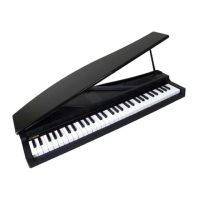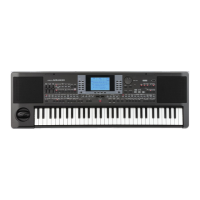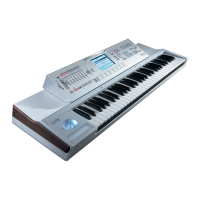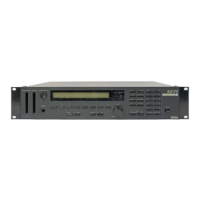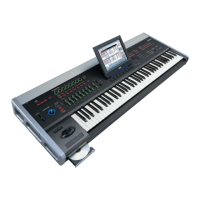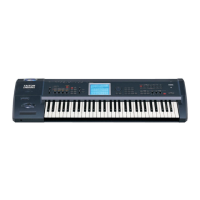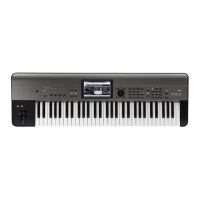4
Front panel
The music stand
8 MEMORY (TIE)
ThisbuttonturnstheLowerandChordMemoryfunctionson
oroff.Gotothe“Page24‐Preferences:controls”editpageto
decide if this button should be a Chord Memory only, or a
Lower/Chord Memory button. When it works as a Lower/
ChordMemory:
ONThesoundtotheleftofthesplitpoint,andthe
chord for the automatic accompaniment, are
kept in memory even when you raise your
handfromthekeyboard.
OFF The sound andchords arereleasedas soon as
youraiseyourhandfromthekeyboard.
ThisbuttondoublesasaTIEfunctionfortheSongmode.
9 BASS INV. (REST)
ThisbuttonturnstheBassInversionfunctiononoroff.
ON
The lowest note of a chord played in inverted
formwillalwaysbedetectedastherootnoteof
thechord.Thus,youcanspecifytothearranger
compositechordssuchasAm7/Gor“F/C”.
OFF The lowest note is scanned together with the
other chord notes, and is not always consid‐
eredastherootnote.
ThisbuttondoublesasaRESTfunctionfortheSongmode.
10 MAN. BASS
ThisbuttonturnstheManualBassfunctiononoroff.
Note:WhenyoupresstheMAN.BASSbutton,theBasstrackvol‐
ume is automatically set to the maximum value. The volume is
automaticallysetbacktotheoriginalvaluewhentheMAN.BASS
buttonisdeactivated.
ON The automatic accompaniment stops playing
(apart for the Drum and Percussion tracks),
and you can manually play the Bass track on
the Lowerpart of the keyboard. You can start
the automatic accompaniment againby press‐
ingoneoftheCHORDSCANNINGbuttons.
OFF The bass track is automatically played by the
Style.
11 SPLIT POINT (<)
Keep this button pressed to open the Split Point window.
Whilethiswindowisopen,youcansetthesplitpointsimply
byplayingthesplitpointnoteonthekeyboard.Then,release
theSPLITPOINTbutton.
Tomemorizetheselectedsplitpointnote,presstheGLOBALbut‐
ton,thenpressWRITEtosavetheGlobalsettingsintomemory.
This buttondoublesas aPREVIOUS EVENTfunction for
theBackingSequenceandSongmodes.
12 G.QUANTIZE (>)
Press this button to open the Groove Quantize window,
where you can select a realtime groove quantization to be
appliedtotheSong(onlySequencer1).
This button doubles as a NEXT EVENT function for the
BackingSequenceandSongmodes.
13 TEMPO (= LOCK)
ThisbuttonturnstheTempoLockfunctiononoroff.
ON When you select a different Style or Perfor‐
mance, the tempo doesn’t change. You can still
changeitusingtheDIALortheTEMPObuttons.
OFF When you select a different Style or Perfor‐
mance, the memorized tempo value is auto‐
maticallyselected.
14
ThisbuttonturnstheSingleTouchfunctiononoroff.
ON When a different Style (or the same again) is
selected,aSingleTouchSetting(STS1)isauto‐
matically selected, meaning that the Realtime
tracks and effects will change, together with
theStyletracksandeffects.
OFF WhenyouselectadifferentStyle(orthe same
again),theStyletracksandeffectsarechanged,
whiletheRealtimetracksarenotchanged.
15 STYLE section (NUMERIC KEYPAD)
UsethesebuttonstoopentheStyleSelectwindowandselect
aStyle.See“SelectingaStyle”onpage 14.
Theleftmostbuttonletsyouselecttheupperorlowerrowof
Stylebanks.Pressituntilyou’veselectedtherowyou’ relook‐
ing for. (After both LEDs have turned on, press the button
againtoturnthemoff).
UPPERLEDON
Upper‐rowStylesselected.
LOWERLEDON
Lower‐rowStylesselected.
A word about Style banks and names. Styles from “8/16
BEAT” to “WORLD 3”, andfrom“LATIN1” to “TRAD”are
standard Styles, the user can’t normally overwrite with a
Loadoperation.
“DIRECT SD” Styles are Styles di
rectly accesse
d from the
memorycard(noneedtoloadfromcard).
Styles from “USER1” to “USER3” are locations where you
canloadnewStylesfromthememorycard.
Eachbutton(Stylebank)contains2pages,eachwithupto8
Styles.BrowsethroughtheStylesusingthePAGEbuttons.
Thereisashortcut
tosee theoriginalbankforaStyle.
You
canseetheoriginalbankwhereaStyleiscontained.Justkeep
theSHIFTbuttonpressed,andthenpressthelefmostbuttonof
the STYLE section. A messagewindow will appear, showing
thenameoftheoriginalbank.ReleasetheSHIFTbutton toexit
thewindow.
Thereisashortcuttoseeallpagesoftheselectedbank.To
cycle all pages for a selected bank, press the bank’s button
untilyouseethepagethatyou’relookingfor.
Thesebuttonsdoubleasa
numerickeypad
oncertainpages.
16 FADE IN/OUT
When the Style stopped, press this button to start it with a
volumefade‐in(thevolumegoesfromzerotothemaximum).
WhentheStyleisplaying,pressthisbuttontostopitwitha
volumefade‐out(thevolumegraduallydecreases).
Youdon’tneedtopressSTART/STOPtostart orstoptheStyle.
17 VARIATION 1–4 (NOTE LENGTH) buttons
Eachofthesebuttonswillselectoneofthefourvariationsof
the current Style. Each variation can vary in patterns and
sounds.
ThesebuttonsdoubleasaNOTELENGTHfunctionforthe
Songmode.
18 FILL 1–2 (NOTE LENGTH) buttons
Thesetwobuttonstriggerafill‐in.Pressthemtwice(LEDblink‐
ing)toletthemplayinloop,andselectanyotherStyleelement
(Fill,Intro,Variation…)toexittheloop.
They also double as a NOTE LENGTH function for the
Songmode.
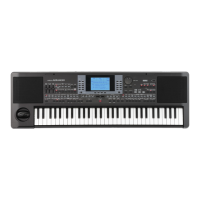
